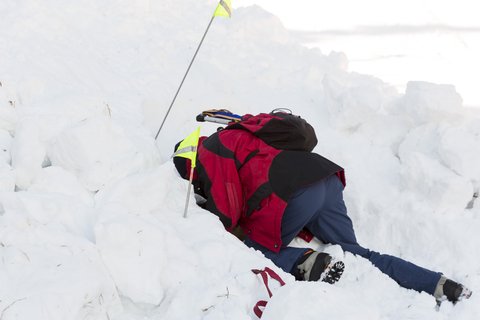Big snows due to El Niño have caused high avalanche dangers in the West. With the increasing number of thrill seekers headed up to the mountains, there is a high probability that more people will unfortunately get buried.
Recently, a search for a lost ski patrolman at Sugar Bowl was called off. It is assumed that he is buried in one of many avalanches that occurred in the out of bounds area he ventured into. As of now, his body has still not been recovered.
In his case (riding solo), nothing could have been done to save him in time. Usually though, people recreating in backcountry environments have a few other people with them, increasing the odds that they will be recovered in the event of an avalanche.
Assuming that the party has some avalanche knowledge and the proper items for avalanche rescue (beacons, probes and shovels), there are some general rules for expediting the recovery.
The A,B,C,D’s of digging have been shown to drastically increase the odds of survival for the victim.
Years ago, when someone got buried, the folks with shovels just started digging like hell in hopes of finding a body part. I have personally dug out a couple of friends this way and they’re darn lucky to be alive today.
Newer techniques make a lot more sense.
The A stands for airway. The basic idea of this is that once the probe hits the victim, it creates an airway. Leave the probe in, work downhill from it and stay off the uphill snow.
B means to determine the burial depth. Once it is determined how deep the victim is, the excavation should extend downhill one and a half times the length of the burial depth. This assumes that the slope is an average slope. One person should start digging here while the other(s) start clearing the area near the probe.
C stands for clearing the snow to the sides. The reason for this is to keep the snow out of the downhill area from building up as the hole becomes deeper. It is extremely important that the snow is only handled once. Remember that time is the most critical factor in a burial.
If there are enough diggers, it is crucial to have two diggers near the probe site and the rest downhill. The two at the probe site have the best odds of reaching a body part.
Lastly, D stands for dig only once. As I stated before, time is critical and the more time spent handling previously handled snow, decreases the odds of survival.
There is also the conveyor method (V-shaped conveyor) of avalanche digging which, in the case of a large search party, greatly increases a speedy recovery.
In this instance, the excavation is started at the downhill location and many shovelers dig a V-shape into the side of the slope. The diggers downhill keep moving the snow to the next downhill digger acting like a conveyor belt for the snow. Usually, there are not enough people in a simple party to make this style effective.
The bottom line is that the chances of survival drop very drastically the longer a victim remains under the snow. Maintaining an airway without caving it in increases the odds of survival as well. Proper digging expedites the recovery.
As traumatic as these situations may be, keeping a cool head and being methodical about the recovery is key and greatly increases the chance of survival.
Photo credit: Dreamstime








